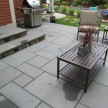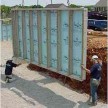Stone Walls
The Art of Stone Walls
You don’t have to be a New Englander to appreciate a well-built stone wall, though it probably helps. The first settlers found stone everywhere, pushed up by the ground as it froze and thawed. Fortunately, the same stones that stopped the plow, defined the boundaries of newly cleared fields. Decades passed. The earth swallowed up the settlers and the forest reclaimed much of the farmland. But the stone walls endure, faithfully outlining the old homesteads, now deep in the woods.
Some understanding of stonewalls and the reason they are built can be understood when you read Robert Frost’s poem, The Mending Wall. Robert Frost is helping his neighbor repair the stone wall that separates their properties.
The Mending Wall
Robert Frost
Something there is that doesn’t love a wall,
That sends the frozen-ground-swell under it,
And spills the upper boulders in the sun,
And makes gaps even two can pass abreast.
The work of hunters is another thing:
I have come after them and made repair
Where they have left not one stone on a stone,
But they would have the rabbit out of hiding,
To please the yelping dogs. The gaps I mean,
No one has seen them made or heard them made,
But at spring mending-time we find them there.
I let my neighbor know beyond the hill;
And on a day we meet to walk the line
And set the wall between us once again.
We keep the wall between us as we go.
To each the boulders that have fallen to each.
And some are loaves and some so nearly balls
We have to use a spell to make them balance:
‘Stay where you are until our backs are turned!’
We wear our fingers rough with handling them.
Oh, just another kind of out-door game,
One on a side. It comes to little more:
There where it is we do not need the wall:
He is all pine and I am apple orchard.
My apple trees will never get across
And eat the cones under his pines, I tell him.
He only says, ‘Good fences make good neighbors’.
Spring is the mischief in me, and I wonder
If I could put a notion in his head:
’Why do they make good neighbors? Isn’t it
Where there are cows? But here there are no cows.
Before I built a wall I’d ask to know
What I was walling in or walling out,
And to whom I was like to give offense.
Something there is that doesn’t love a wall,
That wants it down.’ I could say ‘Elves’ to him,
But it’s not elves exactly, and I’d rather
He said it for himself. I see him there
Bringing a stone grasped firmly by the top 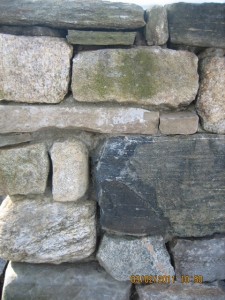
In each hand, like an old-stone savage armed.
He moves in darkness as it seems to me~
Not of woods only and the shade of trees.
He will not go behind his father’s saying,
And he likes having thought of it so well
He says again, “Good fences make good neighbors.
Hardscape Addition
A stone wall can make a beautiful addition to your garden or landscape. There are a variety of different stones you can use to achieve the effect you want. Building a stone wall is hard work, but the end result can be very satisfying.
Your first step is to choose what type of stone you would like to use. It will take quite a large number of stones to build the wall. For structural purposes granite, limestone, slate, and shale work well. There are so many beautiful stones, it may be difficult to choose from them all. Once you have decided on your type of stone, you will need to determine your wall’s volume by multiplying the length times the height times the thickness of the wall. Many stone supplies sell stone by cubic yards. If your measurements are in feet, divide by 27 in order to get the cubic yardage. Other stone suppliers may sell by the ton. Depending on the density it will be somewhere between 12 to 16 cubic feet.
The most obvious place to obtain your stone is through a stone supplier, but if you have property that has old stone walls or lots of rock on the property you may already have your source of stone. You may also be able to get quarry waste if there is a quarry nearby. Construction sites might be another good source for finding stone. Or if you have access to old cellar holes or abandoned buildings you can find fabulous stone there.
to get quarry waste if there is a quarry nearby. Construction sites might be another good source for finding stone. Or if you have access to old cellar holes or abandoned buildings you can find fabulous stone there.
Once you have your stone you will need to sort through it to assemble your “jigsaw puzzle.” Cornerstones need to have two faces that are fairly flat that can meet at right angles. The capstones need to be flat and broad. Ideally your capstones will have enough length to span the entire top of your stone wall. Tie stones need to have enough length for extending through the entire thickness of the wall. They help to strength the wall by bearing onto the smaller stones. Risers are large stones that extend up through the narrower courses and create nice visual breaks from the horizontal joint lines.
A stone wall that is freestanding doesn’t need deep footings like the foundation for a building. However, you do need to have good drainage underneath it. Usually you will want to dig through the top soil to reach down to the solid earth which can be tamped flat and firm. For this you will need to dig a shallow trench.
Outside of the footing stones drive stakes into the ground and stretch some mason’s string between the stakes. The string will help you keep your face stones properly aligned as you lay them. After the ends of the wall are in place, the string lines between the two ends will help to guide you when you are laying the middle of the wall.
Always start on the wall’s ends first. Build the corners before building any of the other sections. You will want to have corner stones that have a minimum of two flat faces which meet closely at 90 degree angles. Use a line level for keeping an eye on the line of mason string as you continue to add stone in the middle of your wall. A curving wall creates new planting areas and features a dry pack construction with a mortared joint cap.
A retaining wall is intended to hold back soil when there is a drastic change in elevation. Often retaining walls are used to terrace yards that original had a steep slope. Additionally, retaining walls can help create usable outdoor space as well as control erosion. Low retaining walls are frequently used as planting beds and can add interest to an otherwise flat yard.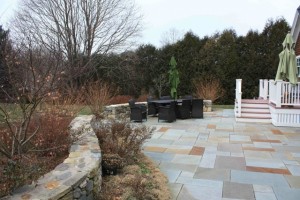
If you are considering hiring someone to build a landscape retaining wall on your property you’ll want to have a basic understanding of what goes into proper retaining wall design. A landscape architect can design a wall and add features and plantings that a landscape contractor can build. This way you’ll be sure to get a quality wall that will last for years without problems. An improperly built retaining wall may bulge, crack or lean, creating an unsightly and efficient headache for you.
Base
First, a retaining wall must be built on a suitable base. Block manufacturers as well as experienced contractors and engineers stress the importance of starting with a good base. The base of a retaining wall should be set below ground level. The taller a wall is, the further below ground level it should be set. Crucial for supporting the rest of the wall, a good base is made of compacted soil and at least a six inch layer of compacted sand and gravel.
Backfill
Second, a retaining wall must have properly compacted backfill. Backfill refers to the dirt behind the wall. In order to provide proper drainage, at least 12 inches of granular backfill (gravel or a similar aggregate) should be installed directly behind the wall. Compacted native soil can be used to backfill the rest of the space behind the wall. If you intend to do landscaping behind the wall, a 6+ inch layer of native soil should also be placed over the gravel fill.
Drainage
Third, since most retaining walls are impervious, which means water cannot pass through the wall itself, efficient drainage is crucial. When drainage goes unaddressed hydrostatic pressure will build up behind the wall and cause damage such as bulging or cracking. There are a number of ways to ensure proper drainage of water from behind a retaining wall. First, is to make sure your landscaping contractor backfills at least a foot of space behind the wall with gravel. Second, is having a perforated pipe installed along the inside, or backfilled, bottom of the wall. And third, is to ask if weep holes will be needed to allow water to drain through the wall.
Height
Fourth, it’s important to know that the height of a retaining wall determines the load it can bear and how much extra reinforcement will be necessary. Typically, residential retaining walls are built between 3 and 4 feet hi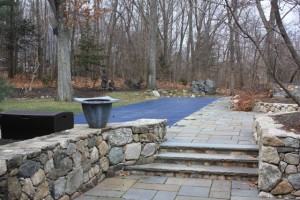 gh. This height provides excellent strength without requiring anchors, cantilevers or other additional reinforcements. If your property requires a higher wall you have two options: you can have the wall specially designed by a structural engineer or you can use a series of 3-4 foot walls to create a terraced effect.
gh. This height provides excellent strength without requiring anchors, cantilevers or other additional reinforcements. If your property requires a higher wall you have two options: you can have the wall specially designed by a structural engineer or you can use a series of 3-4 foot walls to create a terraced effect.
Retaining Wall Design Ideas:
- • Incorporate a fountain or water feature into your retaining wall
- • Integrate an outdoor fireplace into your retaining wall design
- • Install landscape lighting in your retaining wall
- • Include built-in bench seating in your retaining wall
- • Don’t forget steps if you plan to access the area above the wall
A great book on the ‘art’ of stone walls is:
“Storm King Wall” by Andy Goldsworthy at Storm King Art Center in Mountainville, NY.
David Fisher is a Registered Landscape Architect providing site design and site planning services in the Concord, MA area for homeowners, non-profits, and commercial clients. David is currently involved with the Drinking Gourd Project in their efforts to educate the community on the history of abolitionism in Concord. The relocation of the Caesar Robbins House to a site at the North Bridge in Concord to serve as an education center is planned for the Spring of 2011.




